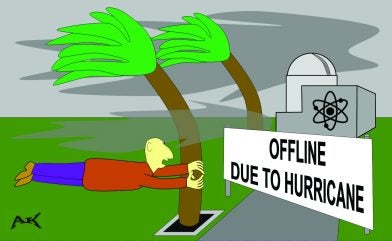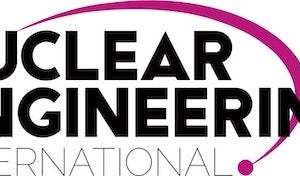
The climate crisis has prompted a reappraisal of nuclear generation with its low- carbon credentials but to deliver on this promise means a robust approach to embracing resilience too. Nuclear has inherent capabilities to address growing climate risk – the industry needs to make sure that the message is getting through
By David Hess, Senior VP, DeepGeo
Last year was the hottest one on record by an unexpectedly large margin. It is unclear what this means. Perhaps the result was a statistical outlier, the kind of fluctuation that it is to be expected when you track an apparently smooth trend over time. Then again, perhaps it was not.
Some people have postulated that this could reflect an acceleration in the planetary temperature rise.
For example, YouTube physicist Sabine Hossenfelder posted a video in March titled: “I wasn’t worried about climate change. Now I am”. This questioned whether leading climate scientists and institutions were wrong about the key sensitivity parameters, quoting research involving the eminent James Hansen. At last count the video had garnered over 1.6 million views.
This defies a comforting narrative which had emerged in the last couple of years suggesting that perhaps we had climate change under control. While confining temperatures beneath 2°C (and certainly 1.5°C) is broadly acknowledged as unrealistic – good for target setting but not on track for being met – an influential group of experts had started to converge on a number somewhere between 2.5 and 3.5°C as the likely limit over pre-industrial times.
Humanity, it seems, had turned a corner and the controversial RCP 8.5 (Representative Concentration Pathways) scenarios found in the IPCC reports could no longer be justified. The impending doom of climate change became measurable and controllable. The fatalism frequently voiced by today’s youth became unfounded.
In 2019, Breakthrough Institute director Ted Nordhaus came up with the analogy of climate change being diabetes for the planet. Yes, still a serious condition, but the remedy was not radical untested medicine. Rather it was the slow and steady planetary equivalent of changing diet, exercise, blood monitoring and regular insulin injections. In this case decarbonisation, electrification and a technology-inclusive, steady approach.
Last year then was a wake-up call. A reminder that even given recent progress governments can’t afford to be complacent. The climate is unsurprisingly a complex system and what we don’t know can – and in all likelihood will – hurt us. So, they must continue to pick up the pace on mitigation efforts. Equally though, they must be more ready than ever to promote investment in the adaptation solutions needed for a climate-changed world.
Among other things, investing in adaption means investing in energy. Energy is the great enabler of modernity and all the comforts and security that brings. In some regions this means building up more energy supplies to meet growing need for air conditioning. In others it means creating a more resilient grid that can withstand an increased intensity (and possibly frequency) of severe storms and climate events.
While the nuclear industry has essentially won the battle for recognition of being a low carbon energy technology and necessary for net-zero at last year’s COP, it has arguably not won the battle of being recognised for its climate resilience attributes and being necessary for adaptation. This is fast becoming a new battleground.
In fact, nuclear plants have been attacked as particularly vulnerable to climate change by the likes of Paul Dorfman, who claims that surging coastal swells and rising oceans could cause a nuclear accident. It has been suggested that wildfires could threaten plants, as could heavier flooding.
There are some individuals and groups that, predictably enough, try to paint the future as one that is too dangerous for nuclear plants to operate in.
This take is naïve. Nuclear operators and regulators will adjust to mitigate any genuine climate risk, just as they mitigate others. Even accounting for the sharp rise in temperature last year, the rate of increase is relatively slow and allows ample time to act. There is simply no urgent reason to shut down existing plants and certainly no reason to prevent new build, where developers will make a full assessment of climate scenarios.
This take is also absurd and ignores the far greater impacts these climate events would surely have on major population centres. Why focus fear solely on nuclear facilities when the weather of such a world would kills thousands and displace millions?
Even where there is no radiological threat, antis point out that there is still a threat as warming waters force nuclear plants to idle during hot water spells. Here at least they have some evidence as the number of forced outages at French nuclear plants (especially) has increased and become an annual media event. Stanford University Professor Mark Jacobson has leant on this as an argument that nuclear has no role to play in the low-carbon future, as it simply cannot be counted on. So much for nuclear reliability!
The banal truth is that no energy source likes the extreme heat and this is why we need to engineer resilient energy systems. Nuclear actually performs better than most renewables during hot spells. In fact, the energy loss of heat-related nuclear outages is imperceptible in global capacity factor figures. It is lost in the noise of strong overall fleet performance. It is entirely possible that performance of the global nuclear fleet will improve in coming years, despite weather disruptions, as lagging operators gradually catch up to best-performers by improving completion of planned outages and reducing the number of unplanned ones.
On the other hand, hydropower output can be devastated by drought, as Brazil has experienced. Evidence also shows that, in Europe at least, the wind often goes away during hot spells. A wind drought to accompany a water one. Solar panels too are less efficient at higher temperatures.
Nuclear is also the only low-carbon energy source that can readily engineer-in greater protection against hot spells, putting in HVAC. If ever truly needed many plants could presumably construct cooling towers in case of permanently lessened water availability. Nuclear plants are also naturally resistant to storm threats in a way that wind turbine and solar panels will never be.
But industry shouldn’t dismiss these climate-related criticisms out of hand. Being resistant to damage from certain weather threats is not the same thing as boosting overall energy resilience. The energy system is only as strong as its weakest link, and during a storm that link is the grid itself.
In fact, nuclear plants will often go offline as a precaution against a cyclone or flood, before the event even reaches them. This is a shame really, as it’s hard to think of a time when that energy might be more desperately needed.
The other part of resilience is recovery, and here too some of the criticism sticks. If there is a grid disruption most of today’s nuclear plants must go into shut down. They will also be the last facilities to come back online as a stable external power supply is a safety perquisite.
Continuing a theme, nuclear technology and operations simply have to step up to meet the needs of a climate- changed world where fossil fuels are all but phased out. One farsighted academic has pioneered work in the subject of how to make nuclear energy more resilient, and the industry should make itself more familiar with the work of Sherrell Greene.
Focusing on two items on the wish list. The ability for future reactors to operate in island mode and to provide black-start capability to the grid could become immensely valuable. Fortunately, this is a feature that is expected of SMR technologies and indeed some vendors (notably NuScale) have marketed this.
If climate change and the need to adapt is the entry point for nuclear resilience, it is certainly not the only external threat industry should be bracing for. The last five years suggest that we are now living through a period where various disruptions are more frequent. The world has bounced from a pandemic, to a commodity and energy crisis, and now faces greater geopolitical instability and the prospect of regional conflicts. Cyber security is an ever greater concern. Who really knows what tomorrow will bring?
We may not all be heading towards the end of days, but we do appear to be living through ‘interesting times’. As an industry obsessed by risk, the nuclear sector is already well-placed to adapt accordingly. Nuclear technologies and the industry itself are indeed crucial to global adaptation efforts.




